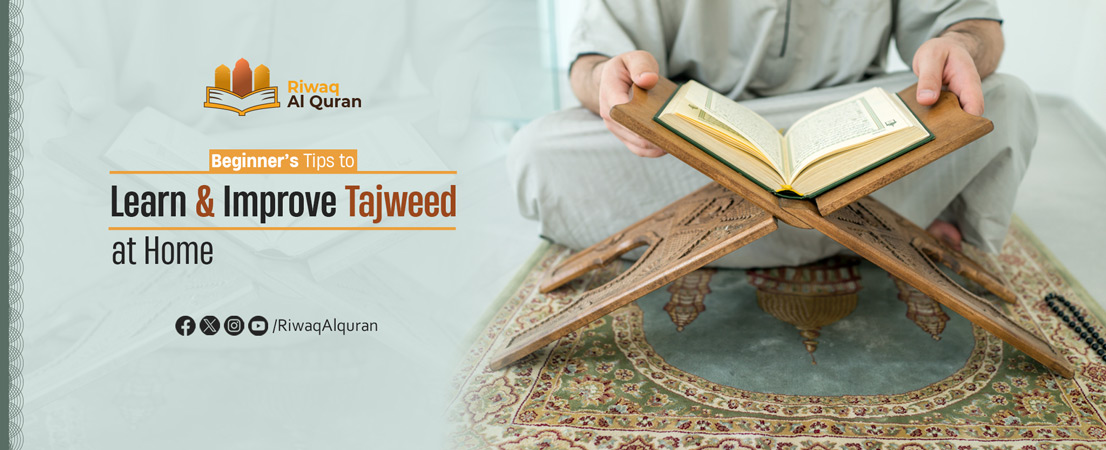Learning Tajweed begins with a strong foundation in the Arabic alphabet, focusing on correct articulation and pronunciation of each letter. For beginners, using interactive tools like flashcards, apps, and engaging visuals can make learning enjoyable and effective.
It is essential to learn one rule at a time, practice consistently, and incorporate rhythmic patterns to reinforce retention. Pairing learning with a qualified teacher ensures proper guidance and error correction, while breaking verses into smaller parts makes the process manageable. Setting a daily routine, even for 10-15 minutes, and practicing slowly with repetition are key strategies for steady improvement.
Here is a story: Ahmad is a 5-year-old student who knows nothing about Arabic. His father is eager to teach him how to learn the Tajweed of the Quran online and read it correctly since there is no Islamic center near his house. At first, the teacher discusses some important issues with Ahmad’s father to make good use of the course. These issues are concerned with the following questions:
Ahmad’s father, now motivated to start teaching his son Tajweed, asks: “How to learn Tajweed for beginners?” The teacher replies:
Table of Contents
1. Start with the Basics
Before diving into Tajweed, it’s essential to learn the Arabic alphabet and how to correctly pronounce each letter. This is the foundation for Tajweed, and without it, the recitation will not be accurate. Begin with simple letters and their basic sounds, and gradually move to more complex ones.
Before diving into Tajweed, you must learn the Arabic letters and their correct pronunciation. Each letter has a unique makhraj (articulation point) and sifaat (characteristics).
Key Steps:
- Identify letter sounds: Practice distinguishing between similar letters (e.g., ت vs. ط, س vs. ص).
- Use beginner books: Resources like Noorani Qaida help with letter recognition and basic Tajweed.
- Listen & repeat: Mimic Quran reciters to train your ear and tongue.
🔹 Tip: Record yourself and compare with expert reciters like Sheikh Al-Hussary or Sheikh Al-Minshawi.
2. Use Interactive Learning Tools
In the beginning, using flashcards or mobile apps can make learning the letters and their sounds more engaging for Ahmad. Interactive methods make it easier for young learners to remember and pronounce the letters correctly.
Recommended Tools:
- Tajweed apps (e.g., Tajweed Quran, Quranic).
- Flashcards for letter recognition.
- YouTube tutorials with visual demonstrations.
- Online Tajweed courses (e.g., Riwaq Al Quran, Bayyinah TV).
🔹 Tip: Gamify learning—set small goals and reward progress!
3. Practice Slowly and Repeatedly
Slowly recite small sections of the Quran, focusing on each letter’s articulation and pronunciation. Repeat the verses several times to build confidence and ensure correct recitation. Repetition is key to mastering Tajweed, especially when starting out.
Tajweed requires patience and consistency. Rushing leads to mistakes.
Best Practice Methods:
✔ Short sessions (15-20 mins daily)
✔ Repeat verses 5-10 times
✔ Focus on one rule at a time (e.g., Ghunna, Qalqala)
✔ Use a Mushaf with Tajweed color-coding
🔹 Example: Start with Surah Al-Fatihah, perfecting each word before moving forward.
4. Teach One Rule at a Time
Focus on one Tajweed rule at a time, like the rules for Noon Sakinah or Meem Sakinah, before moving to the next. Mastering each rule will make the learning process easier and more organized.
Tajweed has many rules—trying to learn all at once is overwhelming.
Beginner-Friendly Rules to Start With:
- Noon Sakinah & Tanween (Izhar, Idgham, Ikhfa, Iqlab)
- Meem Sakinah (Idgham Shafawi, Ikhfa Shafawi)
- Madd (Elongation Rules)
- Qalqala (Echo Sound)
🔹 Tip: Use Tajweed cheat sheets for quick reference.
5. Use Rhythmic Patterns
Incorporating rhythmic patterns into your recitation of the Quran can significantly aid in learning Tajweed. Just as music has rhythm, reciting the Quran can also follow a rhythmic structure that makes it easier for learners, especially children, to remember the Tajweed rules. By associating each Tajweed rule with a particular rhythm or melody, the learning process becomes more intuitive and enjoyable.
Children, in particular, often respond well to this method because it helps them internalize the sounds and patterns of the Quranic recitation. For instance, when practicing the proper elongation of sounds or the articulation of certain letters, you can create a rhythmic beat that reinforces the correct pronunciation.
This method can be especially effective for teaching how to elongate letters (like with madd) or how to pronounce stressed letters (like shaddah). Once the rhythm becomes natural, learners will find it easier to recall and apply the Tajweed rules without conscious effort.
6. Focus on Consistency
Consistency is key to mastering Tajweed. Just like any new skill, repetition is essential for learning the intricacies of Quranic recitation. Even if you only dedicate 10-15 minutes per day, practicing consistently will lead to noticeable improvement over time. The goal is not to rush but to ensure regular practice that gradually builds proficiency.
A daily routine helps learners develop a solid foundation of the rules and sounds of Tajweed, making it easier to apply them during recitation. This daily habit also helps in reinforcing proper pronunciation, preventing mistakes from becoming ingrained.
It is more effective to practice regularly for a short period than to have long, sporadic sessions. Consistency ensures that the rules of Tajweed, such as how to properly articulate each letter or produce the correct nasal sounds, become second nature over time.
7. Learn the Rules of Tajweed
Once you have become comfortable with recognizing and articulating the Arabic letters correctly, it’s time to delve into the core rules of Tajweed. These rules govern how each letter should be pronounced, taking into account factors such as its articulation point (where the letter originates in the mouth or throat), its characteristics (whether it is heavy or light, for example), and how it interacts with other letters.
Understanding the fundamental rules of Tajweed, such as the differences between madd (elongation), ghunna (nasal sound), shaddah (stress), and sukun (absence of sound), is crucial for accurate recitation. These rules are designed to help ensure that the recitation adheres to the exact way the Prophet Muhammad (PBUH) recited the Quran.
Learning these rules will guide you in reading the Quran correctly and preserving the sanctity of the text. It’s helpful to approach these rules systematically—starting with basic concepts and gradually working toward more complex ones. With consistent practice, you will be able to apply the rules of Tajweed naturally in your recitation, leading to a smoother and more accurate performance.
8. Recite with a Teacher
Reciting the Quran with a teacher who can correct mistakes and guide the student is essential. At Riwaq Al Quran, experienced teachers help students learn the nuances of Tajweed, ensuring they recite the Quran as it was revealed, with precision and beauty.
Learning Tajweed on your own can lead to unnoticed mistakes that become habits over time. A qualified Tajweed teacher provides:
✔ Personalized corrections for pronunciation errors
✔ Immediate feedback on makharij (articulation points)
✔ Structured progression from basic to advanced rules
✔ Motivation & accountability in your learning journey
Where to Find a Teacher?
- Riwaq Al Quran offers 1-on-1 online Tajweed classes with certified instructors.
- Local mosques & Islamic centers often have Tajweed circles.
- Ijazah programs for those seeking mastery and certification.
🔹 Hadith: “This Quran has been revealed with Tajweed, so recite it with Tajweed.” (Ibn Majah)
9. Understand the Meaning of What You Read
The Quran is not just about pronunciation; it’s about understanding its message. Ahmad should reflect on the meanings of the verses while reciting. This connection with the Quran will help him appreciate the beauty of Tajweed as he applies it in context.
Tajweed isn’t just about pronunciation—it’s about connecting with the Quran’s message.
How Understanding Helps Tajweed:
- Emotional connection improves khushu’ (humility) in recitation.
- Proper pauses (waqf) make more sense when you know the meaning.
- Correct emphasis on words enhances their impact.
Practical Steps:
- Use a translation Tafsir (e.g., The Clear Quran by Dr. Mustafa Khattab).
- Study word-by-word meanings with apps like Quranic or Tafseer App.
- Reflect on verses while practicing Tajweed.
🔹 Example: Knowing that “رَحْمَةٌ” (mercy) differs from “رَحْمَتٌ” (incorrect) prevents meaning errors.
10. Break Down Longer Verses
Start with shorter surahs or verses and gradually work towards longer ones. Breaking down longer verses into smaller parts will make the recitation process more manageable and help avoid mistakes.
Long surahs can feel overwhelming. Divide & conquer for better Tajweed mastery.
Effective Method:
1️⃣ Start with short surahs (e.g., Surah Al-Ikhlas, Al-Falaq).
2️⃣ Chunk longer verses (e.g., Ayat al-Kursi in 3 parts).
3️⃣ Master one section before moving to the next.
Why It Works:
✅ Reduces frustration
✅ Focuses attention on each Tajweed rule
✅ Builds confidence gradually
🔹 Pro Tip: Use Tajweed color-coded Mushafs (like Mushaf Al-Tajweed) to visually identify rules in each segment.
11. Focus on the Correct Articulation Points
Ensure that Ahmad understands where each letter comes from in the mouth, throat, or nose. This precision in articulation helps improve his Tajweed and ensures correct pronunciation.
The foundation of proper Tajweed lies in pronouncing each Arabic letter from its precise articulation point. Letters originate from different areas:
- Throat (e.g., ع، غ، ح)
- Tongue (e.g., ت، د، س)
- Lips (e.g., ب، م، و)
- Nasal passage (Ghunnah in ن، م)
How to Practice:
- Use diagrams or mirrors to observe mouth positioning.
- Isolate challenging letters (like ض vs. د) and repeat them slowly.
- Listen to experts emphasize each makhraj (e.g., Sheikh Mahmoud Khalil al-Hussary).
Example: The letter “ق” (Qaf) comes from the deep throat, while “ك” (Kaf) uses the tongue’s back. Mixing them alters meanings (e.g., “قلب” [heart] vs. “كلب” [dog]).
12. Be Patient and Persistent
Tajweed takes time to master. Encourage Ahmad to be patient and consistent in his learning. Celebrate small wins along the way to keep him motivated.
Tajweed mastery is a gradual process. Studies show it takes 3–6 months of consistent practice to see significant improvement.
Strategies to Stay Motivated:
- Set small goals: Focus on perfecting one rule per week.
- Track progress: Record recitations monthly to hear improvement.
- Reward milestones: Celebrate completing a surah with Tajweed.
Hadith Reminder:
“The one who recites the Quran with difficulty receives double reward.” (Bukhari). Struggles in learning are themselves rewarded.
Pro Tip: Pair practice with daily Quran listening (even 10 minutes) to reinforce correct sounds subconsciously.


How to Learn Quran with Tajweed at Home?
Ahmad’s father asks: “Since we can’t attend a local center, how can I teach Ahmad Quran with Tajweed at home?” The teacher advises:
1. Find Reliable Online Resources
There are many reputable websites and apps that offer lessons on Quran recitation with Tajweed. Riwaq Al Quran is one such platform, providing certified teachers and a structured curriculum to ensure students receive high-quality instruction.
2. Use Video Lessons and Audio Recitations
Watching videos of teachers reciting the Quran with Tajweed will help Ahmad learn the correct pronunciation. Many websites offer recitations with visual aids, showing the articulation points and demonstrating the rules of Tajweed.
3. Set a Regular Schedule
To make progress, it’s important to set a consistent schedule for learning and practicing at home. Dedicate specific times during the week for Ahmad to study Tajweed and recite with focus. This will help him stay motivated and make steady progress.
4. Monitor Progress Regularly
It’s important to track Ahmad’s progress. Set goals, such as mastering certain verses or rules each week, and review them periodically to ensure that he’s improving.
5. Create a Quiet Learning Environment
Choose a quiet, distraction-free space for Ahmad to practice at home. This will help him focus and concentrate on learning the rules of Tajweed and reciting the Quran correctly.
6. Encourage Self-Study
Encourage Ahmad to listen to Quran recitations on his own and practice what he has learned. The more he listens and repeats, the better his Tajweed will become.
How to Improve Your Tajweed?
The teacher continues his words saying: Of course the time of the class is not enough to master recitation with Tajweed. That’s why we give the students assignments to master the skill. The assignment usually depends on the age and the capacity of the student. The parent’s role is important here to follow up with these tips to make his kid learn to read Quran with Tajweed properly:
1. Repeat, Repeat, Repeat
There are many websites to help in practicing Quran recitation with Tajweed. After mastering the Arabic letters, specify an amount of Ayat according to your capability, listen to them as a whole, then listen to one Ayah or even part of it, then pause and repeat after the Sheikh with your eyes in the Mushaf in all the process. There are many websites that provide the option of selecting the number of times you need to replay.
2. Try to Reflect and Understand What You Read
The Quran is a group of messages from Allah the Almighty to us to understand, reflect on, and apply to reach success here and in the Hereafter. Moreover, understanding the meanings of the Quran is very important; you can choose the translation you prefer from the settings. I suggest Fadel Soliman, Bridges’ translation, and DR. Mustafa Khattab translation.
3. Listen to Quran recitations from various Qaris:
This exposes you to different styles of recitation, helping to improve your Tajweed by hearing various applications of the rules.
4. Record yourself and compare:
Recording your recitation and comparing it with a teacher’s or an expert’s can help identify mistakes you may not notice while reciting.
5. Focus on articulation points:
Pay attention to the exact position of your tongue, lips, and throat when reciting each letter. Proper articulation ensures correct pronunciation and better Tajweed.
6. Practice with a teacher regularly:
Even if you know Tajweed, regular sessions with a qualified teacher are vital for continuous improvement and correction of any recurring errors.
7. Set a consistent practice schedule:
Consistency is key to mastering Tajweed. Set aside time every day for focused practice, even if it’s only for a few minutes, to gradually build fluency.
What Are the 7 Rules of Tajweed?
There are more than seven basic rules of Tajweed, focusing on a different aspect of pronunciation. However, some of the key rules are as follows:
- Iqlaab: Changing the “noon” sound to “meem” when followed by “ب”.
- Idgham: Merging two letters in certain cases.
- Ikhfaa: Hiding the sound of a letter, creating a nasal tone.
- Izhaar: Pronouncing letters clearly without merging.
- Qalqalah: Creating an echoing sound with specific letters like “ق”, “ط”.
- Madd: Extending the vowel sound for a specific duration.
- Ghunna: A nasal sound applied to letters like “ن” and “م”.
How Long Does It Take to Learn Tajweed?
The parent is now curious to know about the duration of the journey for his kid. The teacher says that learning the Arabic letters with their different shapes of vowels and other related basics usually takes about three months in normal conditions. Then learning Tajweed rules can take another 3 months.
But, it undoubtedly differs from one child to another. This means that the normal kid can have the basics of mastering recitation in about one year if he takes 2 hours per week regularly and keeps practicing at home.
How to Hifz Quran at Home Easily?
Memorizing the Quran at home is a profound spiritual journey that connects the heart to the words of Allah in the comfort of one’s own space. It requires creating a peaceful and focused environment that nurtures both discipline and reflection. With a sincere intention and reliance on Allah’s guidance, this journey becomes not only a personal achievement but also a source of immense barakah and blessings for the home.
What Is Ijzazh in Tajweed?
Ijazah in Tajweed refers to the certification given to a student who has successfully learned and mastered a specific book of Tajweed, such as Al-Jazariyyah, and has been granted permission by a qualified teacher. The teacher gives the Ijazah after verifying the student’s mastery of the subject and confirming their ability to apply it.
How to Get Ijazah in Tajweed?
Ahmad’s father asks the teacher: “How can I get Ijazah in Tajweed?”
The teacher answers: To earn Ijazah in Tajweed, you must first learn the Arabic letters and their correct pronunciation. Then, study a book like Al-Jazariyyah and practice reciting the Quran with a qualified teacher. Once you master the rules and recite them correctly, the teacher will grant you the Ijazah.


Learn The Quran with Tajweed for Beginners!
After this rich discussion between the teacher and Ahmad’s father, Ahmad is now ready to take the free trial of the Online Quran classes for kids at Riwaq Al Quran Institute. It’s now possible to learn the Quran with tajweed from the comfort of your home and start such a rewarding endeavor.
Check our online Quran classes for beginners that are specially tailored for all ages and levels and pick what suits you and your child best!
We offer several courses such as:
- Online courses for kids.
- Online Quran classes for kids and adults.
- Online Arabic courses
- Online Ijazah courses
- Online Islamic Studies courses.
Here are a sample of our set of Quran Courses that will be helpful for you:
- Online Tafseer Course: Delve into Quranic meanings with our insightful online Tafseer course.
- Noorani Qaida Online: Learn Quranic basics efficiently through our Noorani Qaida online program.
- Online Quran Recitation Course: Enhance Quranic recitation skills through our expert-led online course.
- Online Tajweed Classes: Master Tajweed rules for beautiful Quranic recitation in online classes.
- Quran Memorization Online Course: Memorize the Quran effectively with our specialized online memorization course.
- Online Qirat Course: Explore diverse Qirat styles with our comprehensive online Qirat course.
- Online Quran Classes for Kids: Nurture a love for the Quran in kids through interactive online classes.
Conclusion
Learning Tajweed is a rewarding journey that enhances the recitation of the Quran, making it more beautiful and precise. With dedication and consistency, anyone can master Tajweed, whether they are beginners like Ahmad or more advanced learners. By following the proper steps, using available resources, and practicing regularly, one can easily improve their Tajweed skills and ensure accurate recitation.
For parents like Ahmad’s father, supporting their child’s Quran learning journey through online classes, interactive tools, and regular practice is essential. With the right guidance and resources, it is possible to learn and improve Tajweed from home, making it accessible for everyone, regardless of their location.


































